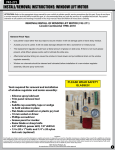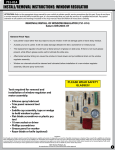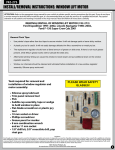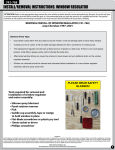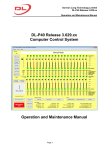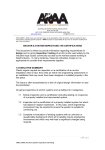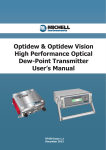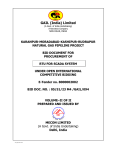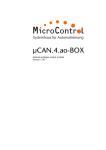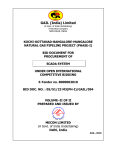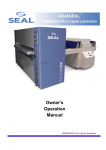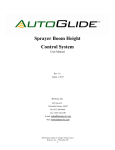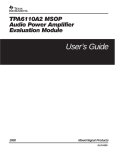Download - Dorman Long Technology
Transcript
Dorman Long Technology Limited DL-P40 Release 3 Operation and Maintenance Manual DL-P40 Release 3 Computer Control System Operation and Maintenance Manual V 3.016a Page 1 Dorman Long Technology Limited DL-P40 Release 3 Operation and Maintenance Manual Index 1. Introduction 1.1. 1.2. 1.3. 1.4. 2. Operating Screens 2.1 2.2 2.3 2.4 3. 5. Manual Mode Auto-lift and Auto-lower modes Jack stroke encoder calibration Operation and maintenance of the system 4.1 Setting up, reconfiguring and dismantling the system on site 4.1.1 Connecting the components together at the start of a project 4.1.2 Changing the layout or replacing components during a project 4.1.3 Dismantling the system at the end of a project. 4.2 Using the system on site 4.2.1 Starting up the system 4.2.2 Checking and amending the CAN node parameters 4.2.3 Checking the system before each use 4.2.4 Carrying out a lifting or skidding operation 4.2.5 Closing down the system 4.3 Maintenance of the system Advanced 5.1 5.2 V 3.016a Main screen System menu on main screen Settings screen Node configuration screens 2.4.1 single node configuration 2.4.2 multiple node configuration Operating modes 3.1 3.2 3.3 4. General Software Hardware Simulation mode Fault diagnosis Work log files Page 2 Dorman Long Technology Limited DL-P40 Release 3 Operation and Maintenance Manual 1.0 Introduction 1.1 General The DL-P40 computer control system is designed to be reliable, safe, simple to set-up and simple to use. The DL-P40 system can be used for the control of up to 40 No. strand jacks or climbing jacks. The program can also be run in simulation mode, where the jack data is taken from a .csv file on the computer rather than from real jacks on a CAN network. This is useful as a demonstration and training aid. The system comprises CAN nodes mounted on the jacks and power packs that collect sensor information and directly control the hydraulic valves, and a control computer that the operator will use to set up, monitor and control the complete system. Communication between all these components is via a CAN line (Control Area Network). For details of the hardware and software please see the relevant sections of this manual. This complete manual is contained in the DL-P40 help file that the operator can view on the control computer at any time by clicking on ‘help’ in the Main Screen. Operating screens The control computer has three main operating screens that the operator will use to set up and operate the system. (For details of these screens please see the relevant sections of this manual): - The main screen. Used for lifting and lowering operations and for calibrating the jack stroke encoders. - The settings screen. Used for setting the parameters for the lifting and lowering operations. - The CAN node configuration screens. Used for checking and amending the user parameters in each of the CAN nodes. Operating modes The DL-P40 has three operating modes (For details of these screens please see the relevant sections of this manual): - Manual mode. Full manual control of all jack functions. - Auto lift mode. Automatic load lifting for one full stroke of the jacks. - Auto lower mode. Automatic load lowering for one full stroke of the jacks. Other software on the control computer There are no known conflicts between the DL-P40 and other software that may be running on the control computer, but nevertheless it can not be ruled out that a conflict does may exist with come software and in some circumstances. It is also imprtant the the operator is concentrating 100% on the DL-P40, and not on other programs. It is therefore ESSENTIAL that all other software programs on the control computer are stopped before running the DL-P40. In particular... - Virus guard programs - Internet browsers - Games V 3.016a Page 3 Dorman Long Technology Limited DL-P40 Release 3 Operation and Maintenance Manual 1.2 Software The DL-P40 control system uses CAN nodes on the jacks and power packs to collect sensor information and to send instructions to control valves on the power packs and jacks. Each CAN node is intelligent, and can make its own decisions using the software loaded onto it to achieve the instructions sent to it by the DL-P40 control computer. The DL-P40 control computer is in overall control of the system. Communication between the CAN nodes and the DL-P40 control computer is made via a 4 wire CAN (Controller Area Network) line, which connecters to the PC via a USBCAN converter. There are therefore 3 separate software programs on the DL-P40 system, plus drivers for the IXXAT CAN-USB Compact: DL-P40 PC software - version 3.xx DL-P40 CAN node program generator - Jack version 3.xx, Power pack V 3.xx IXXAT CAN-USB compact drivers - version 2.18. All the above software is available to download over the internet at www.dormanlongtechnology.com/DL-P40.htm. After down load, the DL-P40 PC software and IXXAT CAN-USB compact drivers should be installed on the control computer. To install these programs simply run the file after download and follow the instructions. The DL-P40 CAN node program installation files link will down load a program that once installed on your PC will be able to create all required CAN node installation files which can be installed into a CAN from a PC through the CAN network. Each CAN node has its own unique CAN ID number, which is what the CAN network uses to identify each node. The CAN ID is written on the front of the CAN node and is also shown on the Settings screen of the DL-P40. The software for each CAN node is loaded into the node at manufacture, but may need to be updated from time to time as new releases are issued. A separate CAN node software installation file is released by DLT for each node, and is named after the CAN ID of the node. The file name begins with an 'L' for a power pack node or an 'S' for a jack node. e.g. File name L_109_V3.01.exe is the version 3.01 installation file for power pack node with CAN ID 109. File name S_110_V3.01 is the version 3.01 installation file for the jack node with CAN ID 110. To generate these CAN node software installation files first download and install the DL-P40 CAN node program generator and install on your PC, then run this program. You will then see a screen as follows : V 3.016a Page 4 Dorman Long Technology Limited DL-P40 Release 3 Operation and Maintenance Manual In ‘Set Parameters’ put in the first and last CAN ID numbers that you wish to generate, For example if you want CAN ID’s 50 to 58, the fill in From 50 To 58. If you just want CAN ID 34 then fill in 34 in both boxes. In ‘Save File Path’ you can select where you want the generated files to be saved. The default is to create a new folder on the desk top and put the files in that folder. This is the most convenient place to find these files, so it is recommended that you do not change this default setting. In ‘Exe File Version’ select whether you wish to generate Power pack CAN node files, or Jack CAN node files. After completing the above 3 steps, press the ‘Generate Node Exe Files’ button to create the node files. You can repeat the above steps as often as you wish to create all the CAN node installation files you need. To install the new CAN node software, simply connect a powered node to a computer through the USB-CAN converter and then run the relevant CAN node software file. This is best done with a single node connected directly to the PC via the USB-CAN converter (with a termination plug in any unused connections), but can also can be done on a fully wired system on site with the CAN nodes mounted on the jacks and power packs. The installation sequence is as follows: 1) Ensure that the control computer and the 24V d.c. power supply to the control system is switched on at every power pack. There will be a separate power on/off switch for each power pack. Note that the power pack motors can be either on or off at this stage. 2) Ensure that all the ball valves on all the power packs are closed, to prevent any possibility of any unwanted actions. 3) Run the CAN node software file for the nodes that you want to update, one at a time. The following screen will appear after running the software file. Press ‘Download’ to install the new program into the node. 4) 5) 6) 7) V 3.016a Turn off the power to all the nodes. Wait 30 seconds and then turn the power back on. The nodes will then re-boot with the new software loaded. Follow the procedures in section 2.4 for checking and amending the parameters. On exiting the node configuration screens the system will re-interrogate the system. Wait until the system re-interrogation is complete and you are returned to the Main Screen. You can now open all the ball valves at the power packs, although generally it is a good Page 5 Dorman Long Technology Limited DL-P40 Release 3 Operation and Maintenance Manual 8) idea to keep them closed at all times when not operating the system. The control system is now ready for use. The IXXAT CAN-USB compact drivers must be loaded onto the control computer before it can communicate with the CAN network through the CAN-USB converter. This is proprietary software provided by the manufacturers of the CAN-USB compact unit. The DL-P40 is designed only to work with version 2.18 of this software and will not work with earlier or later versions. V 3.016a Page 6 Dorman Long Technology Limited DL-P40 Release 3 Operation and Maintenance Manual 1.3 Hardware The DL-P40 hardware comprises the CAN nodes, the sensors, the data cables and the control computer. For the detailed layout of your complete system please refer to the user manual. The DL-P40 hardware has been engineered for work in a building site environment, but nevertheless the hardware can suffer damage from the following: 1) Connecting or disconnecting any of the data cables, including the USB connection to the control computer, when the +24v d.c. power to any of the nodes is switched on. Always switch off the power to all nodes in the system at the power packs whilst connecting or disconnecting any component of the control system. 2) Welding. Never connect a welding earth through a structure onto which a DL-P40 node is mounted. e.g. a power pack 3) Heat. Never use flame cutting equipment near a DL-P40 node or data cable 4) Impact. The DL-P40 nodes should be handled with care and not dropped or hit. 5) Water jet. Never point a high pressure water jet towards any DL-P40 components (e.g. when cleaning strand) 6) Damage to cable connectors. Rough handling of the cable connectors can bend and break connection pins, so always handle with care. DL-P40 CAN nodes should be mounted on the jacks and power packs in an easily viewed location, but out of danger of direct impact. It is not necessary to mount the CAN nodes using rubber isolation mounts. The individual hardware components are as follows: Jack CAN node…… V 3.016a Page 7 Dorman Long Technology Limited DL-P40 Release 3 Operation and Maintenance Manual Power Pack CAN Node….. Any unused connections must be fitted with a termination plug or the system will be unstable. Control computer… The control computer can be any PC or laptop running Windows XP. No other programs should be running at the same time as the DL-P40. USB - CAN adapter…. The USB to CAN adapter can be plugged into any USB2 port on the control computer. The DL-P40 is designed to work with the IXXAT USB-to-CAN Compact Mains power to 24 V DC power supply to the CAN line for working with nodes on the bench. Not required during normal operation. CAN communication line to the first power pack CAN node USB connection to the control computer V 3.016a Page 8 Dorman Long Technology Limited DL-P40 Release 3 Operation and Maintenance Manual Jack sensors (climbing jacks similar) Top anchor grip open / closed sensors. 2 No sensors for open and 2 No sensors for closed, positioned on either side of the anchor. Retract port pressure sensor. Accurate to +/- 0.25% Stroke sensor Sensor accurate to 0.015%. Strand jack electrical dressing set. Common to both DL-P40 and DL-M control systems DL-P40 strand jack CAN node within a protective enclosure box. Extend port pressure sensor. Accurate to +/- 0.25% Extend port bleed valve. Operated by the CAN node for extremely accurate alignment of the load and for smooth load transfer to other support Bottom anchor grip open / closed sensors. 2 No sensors for open and 2 No sensors for closed, positioned on either side of the anchor. V 3.016a Page 9 Dorman Long Technology Limited DL-P40 Release 3 Operation and Maintenance Manual 1.4 Simulation mode As a useful alternative to running the full system with CAN nodes connected, the DL-P40 can be run from a CSV file (Comma Separated Values) containing all the information that the system would normally obtain from the CAN nodes. This is useful for learning to use the DL-P40 and for demonstration purposes. All functions of the DL-P40 are available in simulation mode except for stroke calibration which needs real world sensor information to work properly. To use the simulation mode you select 'Virtual System Simulator' as your CAN adaptor as the program starts. You will then be prompted to select a CSV file which contains all the information needed on the number and type of jacks, power pack arrangement, jack speeds, jack loads, etc.. The DL-P40 then uses this information in place of the information that it would normally receive from the CAN nodes. A number of example simulation files are automatically loaded to the desktop when you install the DL-P40. The CSV files can easily be created and edited using Microsoft Excel. The best way to create new CSV files is to open and edit an existing file then save with a new name. An example CSV file is automatically loaded onto the desktop when the DL-P40 is installed into your computer. A typical CSV file is as follows (when viewed in a text editor such as Windows Word Pad: [GlobalParams],,,,,,,,,,,,,,,,,,,,,,,, E,0.02,,,,,,,,,,,,,,,,,,,,,,, Jacks per power pack,1,,,,,,,,,,,,,,,,,,,,,,, A,700,,,,,,,,,,,,,,,,,,,,,,, [/GlobalParams],,,,,,,,,,,,,,,,,,,,,,,, ,,,,,,,,,,,,,,,,,,,,,,,, [Jacks],,,,,,,,,,,,,,,,,,,,,,,, Serial Number,Type,Max Stroke (mm),Raise Speed (mm/s),Lower Speed (mm/s),Bleed Speed (mm/s),Expected Load (kN),Absolute Max Load (kN),Open Minijack Velocity,Close Minijack Velocity,Upper Dead Band (mm),Lower Dead Band (mm),Randomisation Factor K,Stroke Gain,ENC, Full Bore Gain, Annular Gain, FourMA, Transducer Pressure At 20MA, Piston Extend overrun(0.1mm), Piston retract overrun(0.1mm), Piston Extend Acceleration+(mm/s^2), Piston Extend Acceleration-(mm/s^2), Piston retract Acceleration+(mm/s^2), Piston retract Acceleration-(mm/s^2) J001,S,500,10,20,0.5,1570,1815,0.1,0.1,20,20,0.1,12840,580,19775,9888,6229,400,20,40,490,490,980,980 J002,S,500,10,20,0.5,1570,1815,0.1,0.1,20,20,0.1,12840,580,19775,9888,6229,400,20,40,490,490,980,980 J003,S,500,10,20,0.5,1570,1815,0.1,0.1,20,20,0.1,12840,580,19775,9888,6229,400,20,40,490,490,980,980 J004,S,500,10,20,0.5,1570,1815,0.1,0.1,20,20,0.1,12840,580,19775,9888,6229,400,20,40,490,490,980,980 J005,S,500,10,20,0.5,1570,1815,0.1,0.1,20,20,0.1,12840,580,19775,9888,6229,400,20,40,490,490,980,980 J006,S,500,10,20,0.5,1570,1815,0.1,0.1,20,20,0.1,12840,580,19775,9888,6229,400,20,40,490,490,980,980 [/Jacks],,,,,,,,,,,,,,,,,,,,,,,, The first section of the file is delimited by the "[GlobalParams]" and "[/GlobalParams]" tags, and defines the global parameters of the simulation. Within these tags, the global parameters must be specified: V 3.016a Page 10 Dorman Long Technology Limited DL-P40 Release 3 Operation and Maintenance Manual • • • E - The "stiffness" of the simulated structure. Usually set to 0.02. Jacks per power pack - The number of jacks to be attached to each power pack. A - The A value specifies how quickly the load on the virtual jacks arrives at their expected value as the load is lifted off the ground for the first time. Usually set to about 700 The second section is a table of the virtual jacks. This section is delimited by the "[Jacks]" and "[/Jacks]" tags. The contained table consists of 25 columns. The column headings are not necessary, but make reading table less confusing. 1. Serial Number - The jack CAN node Serial Number to be reported by the software. 2. Type - The Type value must be a single character - either "S" for a strand jack or "C" for a climbing jack. 3. Max Stroke (mm) - The length of the virtual jack's stroke. Typically 500. 4. Raise Speed (mm/s) - The rate at which the jack extends. Typically 30mm/second for a jack lifting at 60 m/hour 5. Lower Speed (mm/s) - The rate at which the jack retracts. Typically 60 mm/second for a jack lifting at 60 m/hour 6. Bleed Speed (mm/s) - The rate at which the jack retracts while bleed lowering. Typically 0.5 mm/second 7. Expected Load (kN) - The load that you want the jack to see in the simulation. can be any value. 8. Absolute Max Load (kN) - The safe working load of the jacks you want to simulate. e.g. for a DLS185 strand jack you should enter 185 x 9.81 = 1815 kN 9. Open Minijack Velocity - The time taken to open a minijack. The units arbitrary. 0.1 is a reasonable value. 10. Close Minijack Velocity - The time taken to close a minijack. The units arbitrary. 0.1 is a reasonable value. 11. Upper Dead Band (mm) - The upper dead band length of the jack. Typically 20 mm 12. Lower Dead Band (mm) - The lower dead band length of the jack. TYpically 20 mm 13. Randomisation Factor K - The K value allows a certain amount of random variation to be added to the raise and lower speed. A value of 0 will cause no variation, while a value of 1 will cause a random variation of between 0 and 200% of the speed entered into 4 & 5 above. Typically set to 0.1. 14. Stroke Gain - A value that will be shown in the jack data at the bottom of the main screen and in the node configuration screen. No other effect. Typically between 10,000 and 14,000 15. ENC - A value that will be shown in the jack data at the bottom of the main screen and in the node configuration screen. No other effect. Typically between 1500 and 3000 16. Full bore gain - A value that will be shown in the jack data at the bottom of the main screen and in the node configuration screen. For the correct settings see the table below. 17. Annular gain - A value that will be shown in the jack data at the bottom of the main screen and in the node configuration screen. For the correct settings see the table below. Full bore gain Annular gain DL‐S15 DL‐S46 DL‐S62 DL‐S108 DL‐S185 DL‐S294 DL‐S418 DL‐S588 DL‐S697 DL‐S836 DL‐S1022 DL‐C125 DL‐C450 752 3171 3171 3931 6480 10702 14743 21480 24332 31554 34845 4566 16439 430 1887 1887 2246 3835 6258 8935 12416 13904 19123 19686 1827 6575 18. FourMA - A value that will be shown in the jack data at the bottom of the main screen and in the node configuration screen. No other effect. usually set to 6229 19. Transducer pressure at 20 mA - A value that will be shown in the jack data at the bottom of the main screen and in the node configuration screen. No other effect. usually 0-400 bar, 4-20 mA transducers used, so set to 400. V 3.016a Page 11 Dorman Long Technology Limited DL-P40 Release 3 Operation and Maintenance Manual 20. Piston extend overrun ( x 0.1 mm) - A value that will be shown in the jack data at the bottom of the main screen and in the node configuration screen, and is used by the simulator to model the distance that the piston will overrun after the command to stop has been sent. Set to about 20.. (i.e. 2mm) 21. Piston retract overrun ( x 0.1 mm) - A value that will be shown in the jack data at the bottom of the main screen and in the node configuration screen, and is used by the simulator to model the distance that the piston will overrun after the command to stop has been sent. Set to about 40.. (i.e. 4mm) 22. Piston extend acceleration+(mm/s^2) - Acceleration of the piston at the start of an extend stroke. Typically 500 mm/s^2 23. Piston extend acceleration- (mm/s^2) - Deceleration of the piston at the end of an extend stroke. Typically 500 mm/s^2 24. Piston retract acceleration+ (mm/2^2) - Acceleration of the piston at the start of a retract stroke. Typically 1,000 mm/s^2 25. Piston retract acceleration- (mm/s^2) - Deceleration of the piston at the end of a retract stroke. Typically 1,000 mm/s^2 V 3.016a Page 12 Dorman Long Technology Limited DL-P40 Release 3 Operation and Maintenance Manual 2.0 Operating screens 2.1 Main screen The main screen is were you can see the status of all the jacks in the system and carry out the heavy lifting operations. The main screen is as shown below... Messages window Information messages are shown here. They can include status information, warnings or errors. If multiple errors have been reported, click on the pane to see a complete list. To cancel warning messages press the Manual Mode button. Jack representation on the main screen Each jack on the system is represented by a vertical line, onto which is placed a stroke indicator and a load indicator. Up to 40 No jacks can be shown on the screen, 20 across the top row and 20 across the bottom row. The position of each jack on the screen is set by the user in the Settings Screen. At the top and bottom of the jack line is a grip open/close indicator. Below each jack line the values of load and stroke are given. A detailed explanation of each of these elements is as follows: Load indicator - Load is shown as a % of the monitor load for each jack. THe monitor load is set by the user in the Settings Screen V 3.016a Page 13 Dorman Long Technology Limited DL-P40 Release 3 Operation and Maintenance Manual Stroke indicator - Stroke is shown as a % of the full stroke of the jack. The most extended jack is shown in red, the least extended jack is shown in blue. Grip state indicators - there are 4 possible grip states as shown below: Open Closed Loaded Unknown State Jack - The name of the jack. This is set by the user in the Settings Screen Load - the measured load in the jack. This can be shown in metric tonnes, KN or US short Tons (2,000 lbs) as selected by the user in System> Preferences Monitor - the monitor load. This is a load set by the user in the Setting Screen for each jack. It can be different for each jack. THe monitor load can either be the expected load for each jack or an actual value read by the system when the Set Load button is pressed. Stroke - The jack stroke. Note that the stroke counter will only start once the load in the jack has reached 50% of the expected load set by the user in the Settings Screen. Lift - The total movement of the load at each jack, since the last time that the Reset Lift Totals button was pressed. Total Column Displays the total loads and lift distances for the complete system Stroke dispersion The difference in measured stroke between the most extended jack and the least extended jack System Menu The system menu gives access to preferences, project files and to the Node Configuration Utility. Start Button The Start button is used to start or stop in auto-lift and auto-lower modes. The button has four possible states: Indicates that the The button in this state system is not ready to has exactly the same The button is shown in start work. The effect as the button in Indicates that the this state when the hardware must be the Start state, but is system is ready to start. system is running an ready and connected, shown if an operation Press to start the operation. Click to Stop and an operation must has been interrupted by specified operation. that operation. be specified before the a warning or by the button becomes Stop button. available. V 3.016a Page 14 Dorman Long Technology Limited DL-P40 Release 3 Operation and Maintenance Manual Operating Mode Buttons Use Operating mode buttons to select from one of three operating modes. Read Actual Loads Click to take a snapshot of the current loads for each jack to populate the "Actual Load" values in the Settings Screen for each selected jack. These values can then be used as the Monitor Load if they are more useful than the expected loads. Calibrate stroke Press this button to start the automatic stroke calibration routine Settings Click to go to the settings screen. Manual Control Buttons The seven manual mode buttons are only enabled in manual mode. Reset Lift Totals Click to reset all the lift values including the total lift value to zero. Select All & Select None Use the Select All and Select None buttons to change the selection state of jacks displayed in the tray. Jacks which are not selected will be excluded from any operation. Jack Details area Full details of all the jack parameters currently set into the Jack CAN nodes. Hover the mouse over a jack to see its parameters. Mouse Park The mouse park is a convenient way of keeping the cursor held out of reach of possibly safety critical buttons when it is not in use. To park the mouse, left click the on the DL logo. To release the mouse, double click with right mouse button. V 3.016a Page 15 Dorman Long Technology Limited DL-P40 Release 3 Operation and Maintenance Manual 2.2 System menu on the main screen The system menu is located at the top left hand corner of the DL-P40 window. Project Files Project Files are used to store information about the current system setup so that they do not need to be entered again after re-starting the DL-P40 system. They contain all of the information entered by the User in the Setting Window. New Project - clears all the data in the Settings Screen Open Project - loads a saved project file Save project As - allows the current project file to be saved under another name Save Project - saves the current project file using the same name Reconnect USB Hardware Selecting this option causes the DL-P40 to interrogate the CAN network. Viewer Mode Selecting this option makes all the controls inactive, but all the jack loads, grip states and jack strokes will be visible in real time. So this option turns the control computer into a Viewing window. Console This facility allows for viewing and instructing the system using CAN commands in Hex language. This facility is only intended for use by trained DLT engineers and for safety is password protected. It is not necessary for normal operation of the system. Node Configuration Utility (Single) Selecting this option opens the Single Node Configuration Screen, where the user can view and change the main parameters in each of the CAN nodes, one at a time. See the separate section on this topic for a detailed description of how to use the Node Configuration Screens. V 3.016a Page 16 Dorman Long Technology Limited DL-P40 Release 3 Operation and Maintenance Manual Node Configuration Utility (Multi) Selecting this option opens the Multi Node Configuration Screen, where the user can view and change the main parameters for all the selected (active) jacks and power pack CAN nodes. See the separate section on this topic for a detailed description of how to use the Node Configuration Screens. Preferences Selecting this option brings up the Preferences window : Length units - can be mm, or inches Weight units - can be Tonnes, kN or US Short tonnes (2000 lbs) Max column percentage - sets the max % of the Monitor Load that can be shown on the screen . Indicate Jacks which are inactive with Loaded Top Anchors - sets the time after which a warning will be given, as care will be needed when retracting the jack and opening the top anchors if the load has been held for some time. Display Load Percentage – the load % will be displayed as a number next to the load arrow on the main screen. Useful if you are trying to load the jacks up to specified % expected loads, typically required during load testing. Display Jack Name in Jack Tray - Option to turn on/off the jack name in the Main Window Highlight Most Extended and Retracted Selected Jacks - if selected then the most extended jack will be shown in red and the least extended jack shown in blue. Enable tool tips - enables useful information to be shown when the mouse hovers over items on the Screens. Load last project at start up - If selected the user will be asked if they want to load the last project file when starting the DL-P40 V 3.016a Page 17 Dorman Long Technology Limited DL-P40 Release 3 Operation and Maintenance Manual Beep on complete auto-lift and auto lower cycle – select if you want an audible beep when the system completes an auto-lift or auto-lower cycle, as a reminder that you need to press the Start button again for the next cycle. 2.3 Settings screen The settings screen is where you can check that all the CAN nodes are present on the system, define the layout of the jacks on the main screen, enter the expected loads for each jack and set the main parameters for carrying out the operation. The settings screen cannot be used to set the parameters into the CAN nodes. This is done in the Node Configuration Screen. V 3.016a Page 18 Dorman Long Technology Limited DL-P40 Release 3 Operation and Maintenance Manual The table contents are as follows: Index A simple row number value. Power Pack Jack Type The power pack type as reported by the power pack node. Serial No. The power pack serial number as reported by the power pack node. Software Indicates the main and boot loader software loaded into both the power pack nodes connected to a Power Pack Index A simple row number value. Type The jack type as reported by the jack node. Serial No. The jack serial number as reported by the jack node. Software Indicates the main and boot loader software loaded into the jack nodes. Name Specifies the user selectable name that will be used in the jack tray. Display Slot Specifies the slot jack tray slot in which the jack will be chosen. The value must be between 1 and 40, and must not conflict with any other jacks in the list Expected Load Specifies the expected load value. Actual Load Lists the Actual Load values, read by the computer when the Read Actual Loads button is pressed in the Main Screen Difference The calculated difference between the expected load and the set load for each jack Load Transfer Distance The distance in mm that the jack has to travel to transfer the load between top to the bottom anchors. The program uses this value 1) in auto-lower mode to work out where to stop the piston at the end of a stroke to leave enough distance to transfer the load, and 2) in auto lift and auto lower mode to check if there has been a gripping failure when the piston is extended with grips closed. In 2) the program checks if the minimum allowable load has been reached by the time the piston has extended by the load transfer distance. It is usual to set the load transfer distance to slightly above the expected value. e.g. for strand jacks and climbing jacks set to 10mm. Max allowable Load Per Jack The max allowable load is set as a % of the Monitor Load. By default it is set to 125%. If this value is exceeded during an operation, the running operation will be stopped, and cannot be resumed until the problem has been resolved using manual mode. Minimum transfer load per jack The minimum load as a % of the Monitor Load that a jack should achieve when the piston is extended by the load transfer distance with the grips closed. The program ignores this feature is a value of Zero is entered. The default setting is Zero. Max Allowable Stroke Range Specifies the maximum allowable difference in stroke between the leading and trailing jack when more than one jack is extending or retracting. In Auto Lift and Auto Lower modes, and in Manual Mode when the Synchronise in Manual Mode option is selected, the DL-P40 will automatically V 3.016a Page 19 Dorman Long Technology Limited DL-P40 Release 3 Operation and Maintenance Manual adjust the Monitor Load The monitor load is the load that will show as 100% load for each jack on the Main Screen. The Monitor load can be selected as either the Expected Load for each jack, or the Actual Load for each jack. The expected load is typed into the setting screen by the user. The set load for each jack is an 'as-measured' load that is read into the computer when the Set Load button is pressed in the main screen. So for example, if the load is much lighter than expected, then the Set loads can be read into the computer and used as the Monitor Load in place of the expected loads. Synchronise Manual Mode Extends and Retracts Tick this box to enable synchronization of the jacks during extend and retract when in manual mode Strand Jacks - Top/Bottom grips Close on Auto-Lift Extend/Retract Stroke Allows the unloaded grips to closed in auto-lift mode when the piston is extending or retracting. The default setting is to select this only for the bottom grips. Opening the top grips during a retract stroke helps to prevent birds nesting of the strands. Opening the bottom grips during and extend stroke helps to reduce wear and dirt build up in these grips but reduces safety as the bottom grips are not able to act as a back up to the top grips if they are held open during an extend stroke. Climbing jacks - Top/Bottom grips Open on Auto-Lift Extend/Retract Stroke Allows the unloaded grips to be held open in auto-lift mode when the piston is extending or retracting. The default setting is for both top and bottom grips to be held open. Interrogate Network Click this button auto-detect any nodes present on the network. The procedure will take around 10 seconds to complete. V 3.016a Page 20 Dorman Long Technology Limited DL-P40 Release 3 Operation and Maintenance Manual 2.4 Node configuration screens The Node configuration Screens are used to view and change the CAN node parameters, which tell the CAN node the properties of the jack or power pack that it is connected to. There are two types of Node Configuration Screens which can be accessed via the System menu : single node and multi node. Single node is used to view and edit the node parameters one node at a time. Multi node is used to view and update all the selected (active) jacks together. Jacks are selected and unselected in the main screen before entering the multi-node screen. The multi node screen is therefore the most useful of the two as it will be quicker to set parameters in all the nodes and easier to spot any discrepancies in values between the nodes. 2.4.1 Single node configuration Select Node Config Utility (Single) from the System Menu and the following screen will pop up: V 3.016a Page 21 Dorman Long Technology Limited DL-P40 Release 3 Operation and Maintenance Manual CAN ID Enter the CAN ID of the node you wish to communicate with. for example, for CAN ID 77, enter 77. Read Pressing this button reads the parameters currently set in the selected node Write Pressing this button overwrites the parameters in the selected node with the values shown on the screen Node type Select either Strand jack (S), Climbing Jack (C) or Power Pack (L). Primary Node For power pack nodes only. Set to checked (Yes) or unchecked (No). The only effect of this parameter is on the settings screen where the connection is shown as A or B for primary nodes, and C or D for other nodes. This facility can be useful for 4 outlet power packs as it allows the user to set outlets A, B, C & D. This parameter has no other effect. Type Number 7 character text field that will appear on the Settings screen. You can enter any text you want, but no spaces. The usual convention is to enter the CAN node number. The S, C or L are added automatically from the Node Type setting. Serial Number 8 character text field that will appear on the Settings Screen. You can enter any text you want, but no spaces. Usual convention is to enter the jack or power pack type. E.g. S588 or L120/2/D JACK PARAMETERS........ Inverted Encoder If the jack stroke indicator on the Main Screen goes down when the jack is extended then the encoder reading needs to be inverted. Check this box to invert the encoder. Milliamp encoder Check this box if variable ampage encoders are used. DLT standard supply is variable voltage encoders, so this box should normally be left blank. Stroke (mm) Enter the stroke of the jack in mm. eg. of the full stroke of the jack is 500mm, then type 500. Dead Zone at top of stroke (mm) An area of the jack stroke that will not be used by the auto lift and auto lower modes, to prevent the possibility of fully extending the jack to the top of stroke whilst under load. usually set to 20 mm (enter 20). In Manual Mode this dead zone is ignored and the cylinder will only stop extending V 3.016a Page 22 Dorman Long Technology Limited DL-P40 Release 3 Operation and Maintenance Manual when the full stroke of the jack is reached. If you want to extend the jack beyond the full stroke in manual mode to apply full pressure to the full bore side of the ram, then set the Dead Zone at top of stroke to Zero. THe DL-P40 will then not stop extending in Manual mode when the full stroke is reached. Dead Zone at bottom of stroke (mm) An area of the jack stroke that will not be used by the auto lift and auto lower modes, to prevent the possibility of fully retracting the jack to the bottom of stroke whilst under load. usually set to 20 mm (enter 20). In Manual Mode this dead zone is ignored and the cylinder will only stop extending when the stroke of the jack is Zero. If you want to retract the jack beyond the fully closed in manual mode to apply full pressure to the annular bore side of the ram, then set the Dead Zone at bottom of stroke to Zero. The DL-P40 will then not stop retracting in Manual mode when zero stroke is reached. Safe working load of Jack (metric tonnes) 1 metric tonne = 9.8066 kN = 1.1023 US short tons = 2,000 lbs Enter the safe working load of the jack. This value is always in metric tonnes, regardless of the load units chosen in preferences. eg for a jack with 185 tonnes safe working load, enter 185. The DL-P40 will automatically stop an operation in Auto-Lift and Auto-Lower modes if the safe working load of any of the jacks is reached. In manual mode a warning will be given, but the operator can continue to operate the jack if absolutely necessary. Safe working pressure of Jack (bar) 1 Bar = 0.1 N/mm2 = 0.1 mpa = 14.504 psi Enter the extend port pressure at the jack safe working load. This value can be obtained form the user manual for the jack. It must always be entered in Bar. eg for a jack with 185 tonnes safe working load @ 290 Bar, enter 290. Full bore to annular area ratio Enter ratio of full bore to annular area ratio. Consult the user manual for the jack to obtain this value. Typically between 1.6 and 2.5. Transducer pressure at 20 mA (bar) 1 Bar = 0.1 N/mm2 = 0.1 mpa = 14.504 psi Enter the max rated pressure for the transducer, at which it will output a 20mA signal. This value must be entered in Bar. for example a 0-400 bar, 0-20 mA pressure transducer, enter 400. Transducer mA at zero pressure (mA) Enter the mA signal for the pressure transducers used that equate to zero pressure. For example, for a 0-400 bar, 4-20 mA pressure transducer, enter 4. Piston extend and retract overrun parameters (mm) This parameter is to allow for the distance the piston will travel from the time that the DL-P40 sends the signal to stop to the piston actually stopping due to inertial forces. This distance can vary from a few mm for slow systems (2-10 m/hour) to as much as 30 mm for very fast systems (40-60 m/hour). If this parameter is set too low then the piston will overrun into the dead zone at the top and bottom of stroke and the DL-P40 will stop in auto-lift and auto-lower modes. If it is set too high then some of the available stroke will be lost. It is better to set this parameter too high V 3.016a Page 23 Dorman Long Technology Limited DL-P40 Release 3 Operation and Maintenance Manual than too low. Manual calibration of stroke encoders...... The jack stroke encoders can be manually calibrated using the node configuration screen if preferred, although using the Stroke Calibration button on the Main Screen is a much quicker and simpler method. Manual calibration using the Node Configuration Screen is carried out as follows, for each jack: 1. Enter the CAN ID of the node 2. Press the Read button 3. Press the 'reset stroke gain and ENC for manual calibration' button. 4. Press the Write button. 5. Exit the Node Configuration Screen 6. Select manual mode and fully retract the jack. Write down the jack stroke reading shown on the Main Screen. 7. Disconnect one end of the stroke encoder from the jack, and fully extend the jack in Manual mode 8. reconnect the stroke encoder, and write down the jack stroke reading shown on the Main Screen. 9. Open the Node Configuration screen 10. Enter the CAN ID of the node 11. Press the Read button 12. enter the two values collected in 6 & 8 above into the 'Screen stroke reading fully extended' and 'Screen stroke reading fully retracted' boxes 13. Press the Write button. The stroke encoder for that jack is now calibrated. POWER PACK PARAMETERS......... Loading valve.. The loading valve is an electronically controlled valve in mini-jack circuit of the power pack that has two positions, On or Off. In the Off position oil is circulated at a nominal pressure from the mini-jack pump back to tank and is not available to open and close the mini-jacks which open and close the grips. In the On position oil is directed to the mini-jack valves at the pressure set by the mini-jack pressure relief valve (usually 50 bar). The loading valve can be set to either be on all the time (but will heat up the oil), on only when the mini-jacks are extending/retracting, or on when ether the mini-jacks or the main cylinders are extending/retracting (only needed for special power packs). The usual setting is On for the mini-jack only. 2 Pos'n MJ valves, 1 lead The are two possible types of valve used to extend and retract the mini-jacks, a 2 position or3 position valve. DLT standard valve is a 2 position valve which is open when energized and closed when not energized. These can be easily recognized by counting only one electrical solenoid lead to each valve. A 3 position valve will have 2 leads to each valve. The DL-P40 needs to be told which type of valve is fitted by correctly setting this parameter in the power pack CAN node. V 3.016a Page 24 Dorman Long Technology Limited DL-P40 Release 3 Operation and Maintenance Manual 2.4.2 Multiple node configuration In the Main Screen, select only the jacks for which you wish to view and edit the node parameters. Then select Node Config Utility (Multi) from the System Menu and the following screen will pop up: When this screen is first shown, the values will be in light gray and are the values currently stored in the memory of the computer. To show a full list of current parameter values in the CAN nodes press Read. The system will then be interrogated and a full set of values will be shown in black, as shown above. The parameters are the same as for the single node screen, see section 2.4.1, except with the following slight variations: Read / Write. Reads and writes to all of the displayed nodes. After reading, changes from the previous values will be highlighted in yellow to aid checking of your work. Manual calibration of stroke encoders...... The jack stroke encoders can be manually calibrated using the node configuration screen, V 3.016a Page 25 Dorman Long Technology Limited DL-P40 Release 3 Operation and Maintenance Manual although using the Stroke Calibration button on the Main Screen is a much quicker and simpler method. Manual calibration of selected jacks using the Node Configuration Screen (multi) is carried out as follows : 1. 2. 3. 4. 5. 6. 7. 8. 9. 10. 11. Press the Read button Click in each of the 'stroke Gain' boxes and select 'Yes' in the pop-up window that will appear asking you if you wish to reset the stroke encoder Gain and EMC values. They will then be reset to default values for taking stroke encoder readings. Do this for all of the jacks. Press the Write button. Exit the Node Configuration Screen Select manual mode and fully retract all the selected jacks. Write down the jack stroke readings shown on the Main Screen. Disconnect one end of the stroke encoders from the jacks, and fully extend the jacks in Manual mode Reconnect the stroke encoders, and write down the jack stroke readings shown on the Main Screen. Open the Node Configuration screen (Multi) Press the Read button Enter the values collected in 5 & 7 above into the 'Screen stroke reading fully extended' and 'Screen stroke reading fully retracted' boxes Press the Write button. The stroke encoders for the selected jacks are now calibrated. V 3.016a Page 26 Dorman Long Technology Limited DL-P40 Release 3 Operation and Maintenance Manual 3.0 Operating Modes 3.1 Manual Mode Manual Mode allows you to take direct control over the system hardware, giving you more freedom. Manual Mode can be activated by clicking the Manual button from the Operating Mode buttons in the Main Screen. Note that manual mode cannot be selected when another operation running. Once manual mode is active the seven manual mode buttons are enabled: 'Open Top', 'Close Top', 'Extend', 'Retract', 'Open Base', 'Close Base' and 'Bleed Lower'. These buttons will send commands to each of the selected jacks. The seven buttons will only cause activity while the button remains pressed. The Up and Down keyboard arrow keys have the same effect as the Extend and Retract buttons respectively. Left and right keyboard arrows have the same effect as Open Base and OPen Top buttons respectively. Extend and Retract operations can be synchronized or free, according to the users selection in the Settings Screen. When synchronized, the DL-P40 will automatically keep all the jack strokes within the Stroke Range entered by the user in the Setting Screen. When in synchronized mode, "Synchro Extend" and "Synchro Retract" are displayed in place of "Extend" and "Retract" respectively. Synchronizing during extend and retract operations leads to more stable distribution of load between the jacks, but may slow the operation down a little as all jacks are forced to go at the speed of the slowest jack. The bleed lower function operates a bleed valve fitted to the extend port of the jack. Pressing the bleed lower button will open this bleed valve and allows oil to flow out of the jack at a slow speed, typically causing the piston to retract at about 1 mm per 3 seconds. Bleed Lower mode is useful for very slowly lowering a load onto it's supports or for precise alignment of a load so that bolted joints can be made. Not all the commands are allowed all the time. Sometimes buttons will become disabled to indicate that their action is impossible or unsafe. The extend and retract buttons will not allow any of the jacks to go beyond their end of stroke (unless the Dead Zone parameter is set to Zero using the Node Configuration Screen), and at least one of the anchors must be closed all the times. 3.2 Auto lift and Auto lower modes The Auto Lift and Lower operations are used to automatically extend or retract the selected jacks for one complete cycle of the ram, or to the end of the current cycle. For Auto-Lift, the cycle starts and stops with the jacks retracted, the load in the base anchors and all grips closed. For AutoLower, the cycle starts and stops with the jacks extended, the load in the base anchors and all grips closed. At the end of each cycle the user must press the Start button again to commence the next cycle. For safety reasons the DL-P40 is not fitted with a lift/lower to a distance facility as this would allow the user to walk away from the control computer for extended periods. Before using the Auto Lift/Lower modes the user must use Manual Mode to: V 3.016a Page 27 Dorman Long Technology Limited DL-P40 Release 3 Operation and Maintenance Manual 1) close all top and bottom anchors 2) Put all the jack strokes within the Maximum Allowable Stroke Range value in the Setting screen. 3) Put all of the jack strokes outside of the Top and Bottom Dead Zones set into the jack CAN nodes using the Node Configuration Screen. To start the Auto- Lift/Lower cycle, press the relevant button: and then press the Start button. At any point in the auto lift/lower cycles the user can Stop the operation by pressing the Stop Button, or any other key on the Keyboard. After pressing the Stop button the user can Resume the operation by pressing the Resume button. The Auto-Lift and Auto-Lower routines will automatically use the jack Extend and Retract Overrun parameters (set by the user for all jacks in the Node Configuration Screen) to stop the jacks clear of the top and bottom Dead Zones (also set by the User for all jacks in the Node Configuration Screen). If for any reason the jacks do go into the Dead Zones, then the Auto Lift/Lower routine will stop and give an error message. The user must use Manual Mode to move all jacks out of the Dead Zones before being able to continue with Auto-Lift/Lower. In this case it would be advisable to increase the Extend and Retract Overrun parameter values before continuing. V 3.016a Page 28 Dorman Long Technology Limited DL-P40 Release 3 Operation and Maintenance Manual 3.3 Jack stroke encoder calibration The quickest, simplest and most accurate way to calibrate all the jack stroke encoders is to use the Calibrate stroke button on the Main Screen. The procedure is as follows: 1. 2. 3. 4. 5. In the main Screen, select only the jacks for which you want to calibrate the stroke encoders Press the Calibrate Stroke Button. (if it is greyed out, then press the Manual Mode button first) You will then be asked whether you want to reset the stroke encoder parameters for all the selected jack. Press yes. The jack CAN Nodes will automatically be re-set and the system re-interrogated. You will then be asked to fully extend all the selected jacks to the end of stroke and press the Set Stroke button (which appears in place of the bleed button at the bottom of the manual buttons) and then fully retract all the jacks to bottom of stroke and press the Set Stroke button again. Press OK and carry out these 2 operations. The system will then automatically update the stroke parameters on all the selected nodes and re-interrogate the system. For the alternative method using the Node Calibration Screen, see the description on that page of this help file. V 3.016a Page 29 Dorman Long Technology Limited DL-P40 Release 3 Operation and Maintenance Manual 4.0 Operation and maintenance of the system 4.1 Setting up, reconfiguring and dismantling the system on site The exact layout of the CAN nodes and data cables for each system will vary with the number and type of power packs you have, however the basic principles given here will apply to all systems. 4.1.1 Connecting the components together at the start of a project The components of the DL-P40 system comprise the control PC, the USB to CAN signal converter, the data cables, the Power pack CAN nodes, the Jack CAN nodes and the sensors. These components are described in section 1.3 and the precise layout for your system will be shown on a drawing within the Operation and Maintenance manual that you should have with your system. The sequence for connecting the components together is as follows : 1) 2) 3) 4) 4.1.2 1) 2) 3) 4) 4.1.2 1) 2) 3) V 3.016a Ensure that the 24V d.c. power supply to the control system is switched off at every power pack. The on/off switch for this power supply will usually be a red circular isolator switch, but please see your Operation and Maintenance manual for details.. There will be a separate power on/off switch for each power pack. Note that the power pack motors and the control computer can be either on or off at this stage. Ensure that all the ball valves on all the power packs are closed, to prevent any possibility of any unwanted actions. Connect all the components of the DL-P40 system together, including the USB connection to the control computer, following the layout drawing given in your Operation and Maintenance manual. The system can then be switched on at the power packs and used... see section 4.2. Changing the layout or replacing components during a project. Ensure that the 24V d.c. power supply to the control system is switched off at every power pack. There will be a separate power on/off switch for each power pack. Note that the power pack motors and the control computer can be either on or off at this stage. Ensure that all the ball valves on all the power packs are closed, to prevent any possibility of any unwanted actions. Make the required changes to the DL-P40 system and then connect all the components of the DL-P40 system together, including the USB connection to the control computer, following the layout drawing given in your Operation and Maintenance manual. The system can then be switched on at the power packs and used... see section 4.2. Dismantling the system at the end of a project. Ensure that the 24V d.c. power supply to the control system is switched off at every power pack. There will be a separate power on/off switch for each power pack. Note that the power pack motors and the control computer can be either on or off at this stage. Ensure that all the ball valves on all the power packs are closed, to prevent any possibility of any unwanted actions. Dismantle the system and pack away. See section 4.3 for maintenance tasks prior to packing. Page 30 Dorman Long Technology Limited DL-P40 Release 3 Operation and Maintenance Manual 4.2 Using the system on site. This control system should only be operated by competent trained staff, working under the overall direction of a competent trained Lift Master. Please refer to the Operation and Maintenance manual for your system for specific guidance on using the equipment to carry out a heavy lifting or skidding operation. This section covers the basic procedures common to all DL-L40 systems for starting, commissioning, operating and shutting down the system. 4.2.1 Starting up the system Every time you turn on the system it is important that you use the following procedure to ensure the safety of the site and to avoid any damage to the system : 1) Ensure that the 24V d.c. power supply to the control system is switched off at every power pack. There will be a separate power on/off switch for each power pack. Note that the power pack motors and the control computer can be either on or off at this stage. 2) Visually inspect all the components of the system to make sure no physical damage has occurred since last use and that all the data cables are properly connected. 3) Ensure that all the ball valves on all the power packs are closed, to prevent any possibility of any unwanted actions. 4) Turn on the 24V d.c. power supply to the control system at every power pack, and turn on the control computer (if not on already). 5) Start the DL-P40 program by clicking on the desk top icon 6) Select CAN Adaptor Type ‘Ixxat CAN-to-USB Compact’ when asked and press OK. 7) Wait whilst the DL-P40 system is interrogated. During the interrogation phase the system is communicating with all the Power pack and Jack CAN nodes. 8) Enter the project settings. After system interrogation is complete you have the option to either load a previous project settings (System>Open Project) or go to the Settings screen to enter the project settings manually – see section 2.3. It is always a good idea to open the settings screen first to check that all the nodes on the system have been identified. 9) You can now open all the ball valves at the power packs, although generally it is a good idea to keep them closed at all times when not operating the system. 10) The control system is now ready for use. 4.2.2 Checking and amending the CAN node parameters The CAN node parameters define the properties of the jacks and power packs in the system, and it is therefore important that they are set correctly. The following procedure should be used to check and amend these parameters: 1) Ensure that the control computer and the 24V d.c. power supply to the control system is switched on at every power pack. There will be a separate power on/off switch for each power pack. Note that the power pack motors can be either on or off at this stage. 2) Ensure that all the ball valves on all the power packs are closed, to prevent any possibility of any unwanted actions. 3) Start the DL-P40 program and go to the Main Screen..if not already there. 4) Follow the procedures in section 2.4 for checking and amending the parameters. On exiting the node configuration screens the system will re-interrogate the system. 5) Wait until the system re-interrogation is complete and you are returned to the Main Screen. 6) You can now open all the ball valves at the power packs, although generally it is a good idea to keep them closed at all times when not operating the system. 7) The control system is now ready for use. V 3.016a Page 31 Dorman Long Technology Limited DL-P40 Release 3 Operation and Maintenance Manual 4.2.3 Checking the system before each use At the start of each shift it is an important safety requirement to check that the system is still functioning correctly using the following procedure: 1) Start up the system as described in 4.2.1. 2) Check the CAN node parameters as described in section 4.2.2. To quickly scan the node parameters it is best to use the multiple node option. 3) On the Main Screen, check that all the anchors are shown as closed (green) and the load and stroke readings are showing and look approximately right. 4) In Manual mode, open all the unloaded anchors. Check that the anchor colours all go from green through yellow to red. Then close all these anchors. 5) If it is safe to do so (ask your Lift Master), in Manual mode transfer the load to the other anchors by extending or retracting the main cylinders as appropriate, and check the correct operation of the load and stroke readings as you do so. 6) If 5) was possible (ask your Lift Master), In Manual mode, open all the unloaded anchors. Check that the anchor colours all go from green through yellow to red. Then close all these anchors. 7) If checks 5) and 6) were performed, then transfer the load back to the safe anchor (bottom anchor for strand jacks, top anchor for climbing jacks). 8) If it is necessary to change any of the components of the system to correct a fault, then follow the procedure in 4.1.2. and then re-check to see that the fault has been cleared. Remember to close all ball valves and turn off the power to the system at all power packs before working on the system. 9) The system is now checked and ready for use 4.2.4 Carrying out a lifting or skidding operation The most important criteria for a safe operation is that there is a detailed plan of work and that all the staff involved are competent, properly trained and properly briefed on the specific operation to be carried out. There needs to be a single person in overall control of the operation (the Lift Master) who is in communication with the DL-P40 operator and all other staff involved in the operation. The DL-P40 operator should not be the Lift Master as well. General guidance on the safe planning and execution of a lifting and skidding operation are given in the Operation and Maintenance manual that came with your system. It is not uncommon in complex heavy lifting operations for there to be a pause whilst events are considered by the team, and in these satiations it is always a good idea to close all anchors and then close all the ball valves on all the power packs. This action will leave the system safe and prevent any unwanted actions whilst the site team consider their next move. The basic steps for performing an operation with the DL-P40 are as follows: 1) Start up the system as described in 4.2.1, including entering the project settings. The project settings will include the expected load in each jack, the maximum allowable load in each jack (as a % of the expected load) and the maximum allowable stroke range to suit the load being lifted. 2) Check the CAN node parameters as described in section 4.2.2. To quickly scan the node parameters it is best to use the multiple node option. 3) Check the correct operation of the system as described in section 4.2.3. 4) Operate the system as instructed using the Main Screen – see section 2.1. 5) On completion of the operation, or at the end of each shift, close down the DL-P40 system as described in section 4.2.5. V 3.016a Page 32 Dorman Long Technology Limited DL-P40 Release 3 Operation and Maintenance Manual 4.2.5 Shutting down the system At the end of an operation, or at the end of each shift, the system should be shut down as follows: 1) Make sure the jacks are in a safe condition, with all anchors confirmed closed. 2) Close all the ball valves on all the power packs 3) Close the DL-P40 program on the control PC 4) Turn off the 24V dc electric supply to the control system on all the power packs and turn off the control computer, in any order. 4.3 Maintenance of the system The control systems are designed for minimal maintenance, but it is recommended that the following maintenance procedures are followed: Prior to the start of each project: • Thoroughly clean all the cables and connections using white spirit and dry. • Spray water dispersal oil (WD40) onto the connection pins • Visually check the condition of all components, looking for damage or corrosion. • Replace plug caps on any plugs not be used • Fully assemble the system on the power packs and jacks and carry out a function testing to check that all required components are present and working correctly • Pack spare parts for maintenance on site. Between successive operations on each project: • Visually check the condition of all components, looking for damage or corrosion. At the end of each project: • Thoroughly clean all the cables and connections using white spirit. • Spray water dispersal oil (WD40) on all the connecting pins • Replace plug caps on all plugs • Coil and tie all the cables and place in a box for transportation and storage between projects, to minimise the chances of damage. • The jack sensors can remain on the jacks for transport between sites, but should be properly protected from damage during handling. V 3.016a Page 33 Dorman Long Technology Limited DL-P40 Release 3 Operation and Maintenance Manual 5.0 Advanced 5.1 Fault diagnosis Use the following guide to understand and correct faults that may occur in the DL-P40 system. Symptom Possible Causes & remedies No CAN nodes shown in the setting Screen after completing system interrogation. Thoroughly check all CAN cables for loose or dirty connections and broken wires or... Check that the USB to CAN Compact is connected to the control computer and is showing a green light, i.e. communication has been made between the computer and the CAN to USB compact Not all the CAN nodes are showing in the setting screen after completing system interrogation Check that all unused plugs on the power pack nodes have termination plugs fitted If no green light on the CAN to USB compact, then try another one to see if the first unit is the problem. Try another USB port to see if that is the problem. If not then re-install the IXXAT drivers on the control computer. Using the Node Configuration Screen, check that all the power pack nodes have been configured to be power pack nodes (Serial number begins with L, not S). Power supply failure to some of the nodes. Check that all nodes have power (lights flashing on the front of the node shows that they have power). If all above OK, then just make the connection to the first power pack node and put a termination plug in the CAN out connection. Interrogate the system. Can you see the first node? If yes, then progressively add power pack nodes to the network, one at a time, until the problem node is identified. If no, then disconnect the jack CAN lines and put in termination plugs. If this helps, then check the jack nodes one at a time to find the faulty node. If this does not help then swap the first power pack node with another one to see if it is the first node that is the problem. Follow this logical manner to identify the problem node(s) If a problem node is identified that will not communicate with the DLP40, try to repair the node by. A) reload the node software (see software section) then B) use the Node Configuration Screen in the DL-P40 to check and reset the node parameters. If A) fails then the node has been damaged and needs to be returned to DLT for repair. Damage can be caused by lightening strikes, high electrcal discharge close to the nodes (welding), excessive heat (from flames) and heavy impact and high pressure water jets. Jacks do not extend or retract in Auto-lift or V 3.016a The Stroke Range parameter in the Setting Screen has been set too low. Increase the value. Page 34 Dorman Long Technology Limited DL-P40 Release 3 Operation and Maintenance Manual Auto-lower mode, or in manual mode with Synchro extend/retract turned on Some of the jacks are too near the Dead Zones at the top of bottom of the jack stroke. Use manual mode to move them away form the dead zones. Auto-lift or Auto-lower routines are stopping with the error message that jack xx is out of range. The jacks are overrunning too far, and going into the dead zones at the top or bottom of the stroke. Increase the Overrun parameter in the affected jacks using the Node Configuration Screen Jacks are seen to extend on the screen when they Change the inversion of the stroke encoders using the Node are actually retracting, or Configuration Screen visa-versa. The reported jacks loads The jack loads are calculated by the DL-P40 from the pressures at both are incorrect ports of the jack, the jack area and the Main bore to Annular area ratio. Check that these parameters have been correctly entered into the jack CAN nodes using the Node Configuration Screen. Any of the above or other symptoms V 3.016a Check that all other software on the control computer is closed. In particular.. - Internet browsers - Virus protection programs - Games Page 35 Dorman Long Technology Limited DL-P40 Release 3 Operation and Maintenance Manual 5.2 Work Log files The DL-P40 automatically creates a detailed log file of all operations every time that the system is run. The log file contains the load, stroke and anchor (Clamp) states of all of the jacks at no more than 2 second intervals and all of the commands given by the user to the nearest second. Log files are useful in analyzing what has happened after the operation has finished or has been stopped. The log files are written in CSV format which enables them to be processed by popular data analysis tools such as Microsoft Excel. The current log file can not be read whilst the operation is continuing as the file is open until the DL-P40 program is closed. A typical log file is a follows. it is fairly self explanatory , but for a detailed evaluation of log files, please contact Dorman Long Technology. V 3.016a Page 36





































